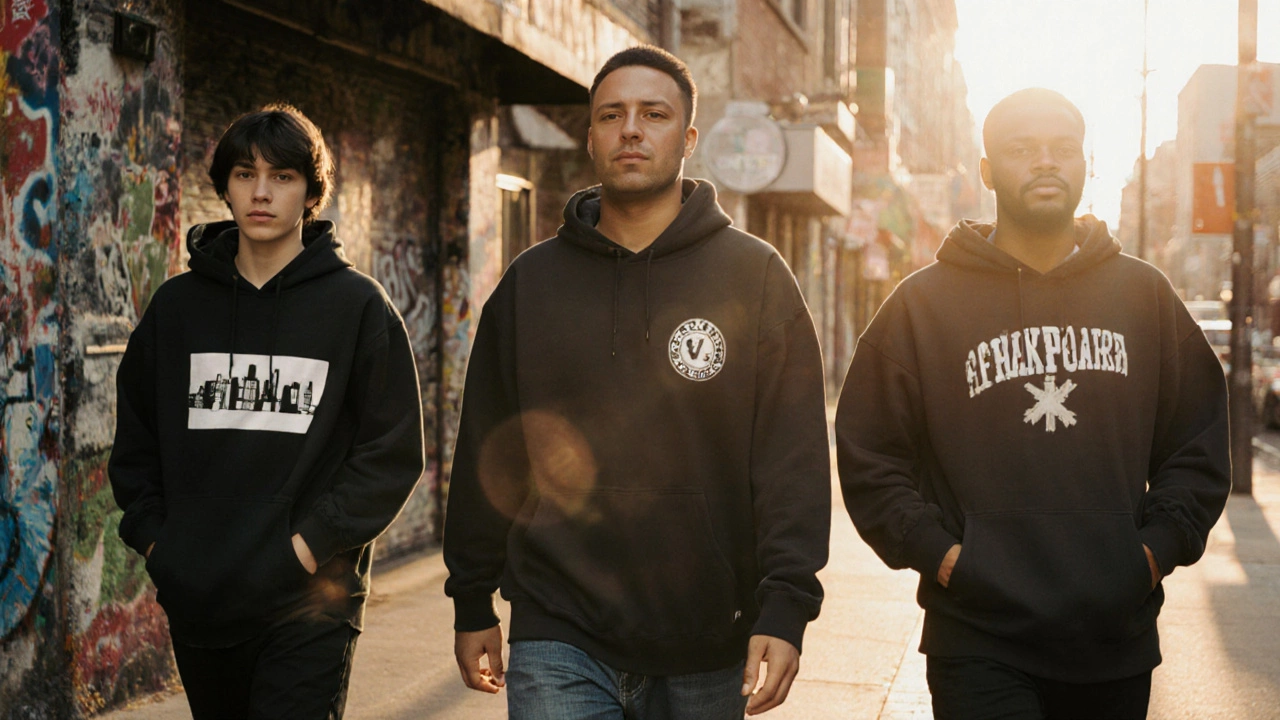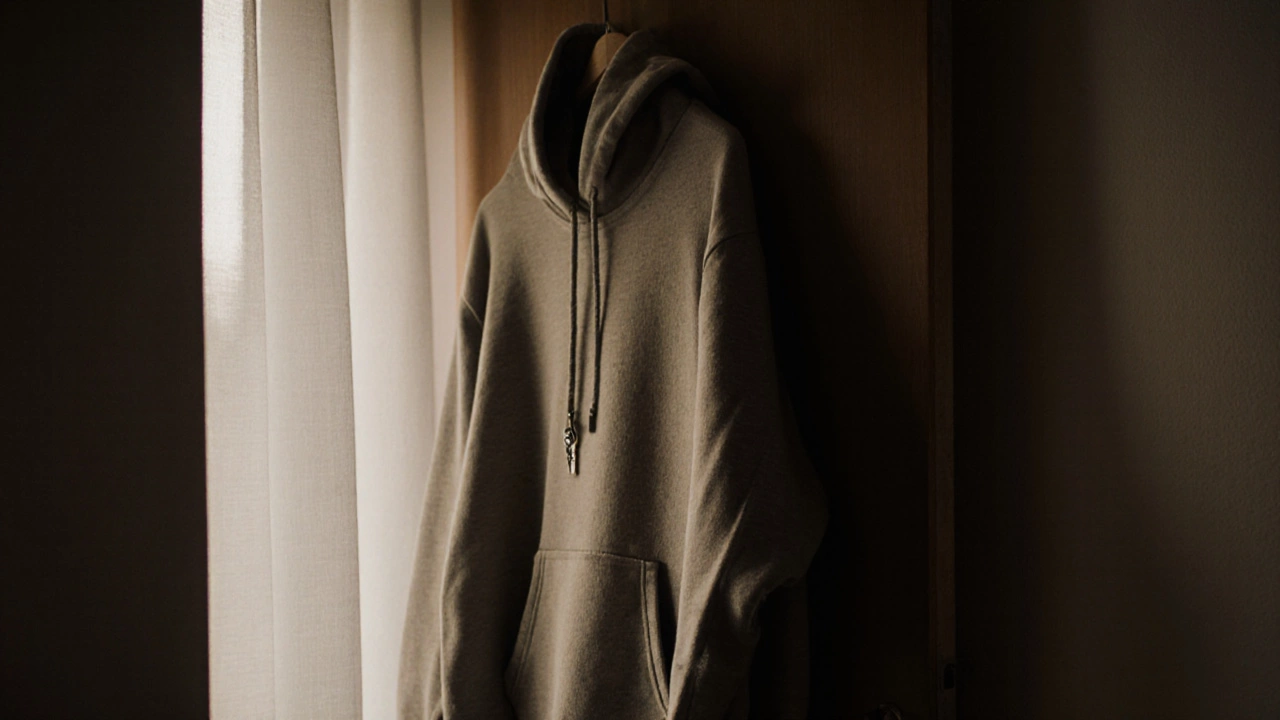Hoodies aren’t just clothing. They’re a second skin for millions of people-students pulling all-nighters, baristas between shifts, parents chasing toddlers, and remote workers logging in from the couch. If you’ve ever pulled one on after a long day and felt an instant wave of calm, you already know why they’re so nice. But it’s not just soft fabric and a drawstring. There’s history, psychology, and culture woven into every thread.
They’re Designed for Comfort, Not Just Style
Hoodies started as workwear. In the 1930s, Champion created them for athletes training in freezing New York warehouses. The hood? It kept necks warm. The thick cotton fleece? It absorbed sweat. The loose fit? It let you move. That’s not fashion-that’s function. And that’s why they still feel so good today.
Modern hoodies keep improving. Brands now use ring-spun cotton, which is softer than regular cotton because the fibers are twisted tighter. Some add a brushed interior for extra warmth without bulk. Others blend in moisture-wicking polyester for gym sessions. Even the drawstrings have changed-no more plastic ends that snap off. Now you’ll find silicone tips or woven lace that stays put.
Think about how you feel when you wear a hoodie. Your shoulders relax. Your chest doesn’t feel tight. You don’t have to tuck it in or adjust it constantly. That’s not an accident. It’s the result of decades of refinement aimed at one thing: making you feel safe and at ease.
They Work Everywhere-No Matter What You’re Doing
Try this: wear a blazer to the grocery store. See how many people stare. Now wear a hoodie. No one bats an eye. Hoodies don’t care if you’re running errands, going to a coffee shop, or Zooming into a meeting. They’re the ultimate non-judgmental garment.
That’s why they’ve crossed every social boundary. CEOs wear them to startup board meetings. College professors wear them grading papers. Athletes wear them on the sidelines. Even fashion houses like Balenciaga and Gucci sell hoodies for over $1,000. Why? Because the hoodie doesn’t ask you to be anyone you’re not. It lets you show up as yourself.
There’s no dress code for a hoodie. You don’t need to match it with pants or shoes. You don’t need to worry about wrinkles or stains. It’s forgiving. And in a world that demands you look polished all the time, that’s revolutionary.

The Hoodie Is a Shield-And a Signal
There’s something deeply human about pulling a hood over your head. It’s not just about warmth. It’s about control. When you’re overwhelmed, anxious, or just need a moment alone, the hood creates a small personal bubble. It’s a quiet way to say, ‘I’m here, but I’m not ready to engage.’
At the same time, it’s also a signal. A hoodie with a band logo? You’re telling people you like that music. A hoodie with your hometown’s name? You’re proud of where you’re from. A hoodie with a nonprofit’s logo? You care about their cause. It’s wearable identity without saying a word.
That’s why hoodies became central to movements. Think of the hoodie worn by Trayvon Martin in 2012, which turned into a symbol of protest against racial profiling. Or the way streetwear brands turned hoodies into canvases for political art. A hoodie isn’t just clothing-it’s a statement you can carry in your pocket.
They’re the Only Thing That Feels Like Home
When you’re traveling, the first thing you pack? Your favorite hoodie. It’s not because it’s the warmest or the most stylish. It’s because it smells like your house. It’s worn in just the right places. The sleeves are stretched from your arms. The pocket holds your keys just right. You know exactly how it drapes over your shoulders.
That’s why people keep hoodies for years-even when they’re faded, thin, or have a hole near the elbow. We don’t throw them away. We retire them. We give them to our siblings. We hang them on the back of the door like a memory. A hoodie becomes part of your story.
Studies show that people feel more secure when wearing familiar clothing. It’s called ‘enclothed cognition’-the idea that what you wear affects how you think and feel. A hoodie doesn’t just cover your body. It wraps you in a sense of continuity. In a world that changes fast, that’s priceless.

They’re Affordable, Accessible, and Everywhere
You can buy a hoodie for $10 at a discount store or $300 from a luxury brand. Either way, you’re getting the same basic shape: a pullover, a hood, pockets, and sleeves. That simplicity is its power.
Unlike jeans or dresses, hoodies don’t require tailoring. They don’t need belts, buttons, or zippers to fit right. They stretch. They shrink. They adapt. And because they’re so easy to make, they’re available everywhere-from small-town thrift shops to online marketplaces in rural villages.
That accessibility means hoodies belong to everyone. A kid in Lagos, a retiree in Toronto, a student in Jakarta-they all have a hoodie. It’s the one garment that doesn’t care about your income, your language, or your culture. It just fits.
They’ve Outlasted Every Fashion Trend
Remember bell-bottoms? Shoulder pads? Neon leg warmers? Those came and went. But hoodies? They’ve been around for nearly a century and are more popular now than ever.
Why? Because fashion changes. Human needs don’t. We still want comfort. We still want to feel safe. We still want to belong. Hoodies answer all three.
They survived the rise of athleisure, the collapse of formal office wear, and the shift to remote life. Even when ‘quiet luxury’ was the buzzword, people didn’t ditch their hoodies. They just bought them in neutral tones and premium fabric.
Hoodies aren’t trendy. They’re timeless. And that’s why they’re so nice. They don’t try to impress. They just show up-and make you feel better.
Why do hoodies feel so comforting?
Hoodies feel comforting because they’re designed with soft, loose fabrics that reduce physical stress on the body. The hood creates a sense of privacy and safety, while the weight of the material-like fleece or cotton blend-triggers a calming sensory response. Studies in psychology show that familiar, soft clothing reduces cortisol levels, helping people feel more relaxed.
Are hoodies appropriate for work?
Yes, if the workplace allows casual attire. Many tech companies, creative agencies, and remote-first teams have adopted hoodie-friendly dress codes. Even in more formal environments, a well-fitted, solid-color hoodie under a blazer or cardigan can be professional enough. It’s less about the hoodie itself and more about context and fit.
What’s the difference between a hoodie and a sweatshirt?
The main difference is the hood. A sweatshirt is a pullover top without a hood. A hoodie includes a hood, usually with a drawstring. Many hoodies also have front pockets, while sweatshirts often don’t. Functionally, hoodies offer more warmth and coverage, making them better for outdoor use or colder weather.
Why are hoodies so expensive at luxury brands?
Luxury hoodies cost more because of the materials, craftsmanship, and branding. High-end brands use organic cotton, Japanese fleece, or recycled polyester with advanced dyeing techniques. They often produce in limited batches, hand-finish seams, and include designer logos that carry cultural weight. You’re paying for quality, exclusivity, and identity-not just a piece of clothing.
Can hoodies be worn in formal settings?
Traditional formal events like weddings or black-tie dinners aren’t hoodie-friendly. But modern formal-adjacent settings-like gallery openings, casual business dinners, or creative industry events-can absolutely work with a sleek, minimalist hoodie paired with tailored trousers and clean shoes. It’s about balance and intention.

